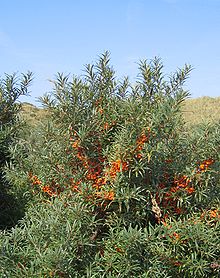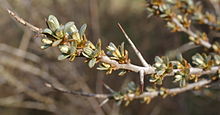- Hippophae rhamnoides
-
Common sea-buckthorn Common sea-buckthorn shrub in The Netherlands Scientific classification Kingdom: Plantae (unranked): Angiosperms (unranked): Eudicots (unranked): Rosids Order: Rosales Family: Elaeagnaceae Genus: Hippophae Species: H. rhamnoides Binomial name Hippophae rhamnoides
L.Hippophae rhamnoides, the common sea-buckthorn, is a deciduous shrub species in the genus Hippophae.
Common Sea-buckthorn branches are dense, stiff, and very thorny. The leaves are a distinct pale silvery-green, lanceolate, 3-8 cm long and less than 7 mm broad. It is dioecious, with male and female flowers on separate plants. The brownish male flowers produce wind-distributed pollen. It is a non-legume nitrogen fixer. The fruits are a bright orange.
Contents
Habitat
Usually found near the coast forming thickets on fixed dunes and sea cliffs.
Range
Hippophae rhamnoides is a native plant throughout Europe, including Britain, from Norway south and east to Spain and Asia to Japan and the Himalayas. It is grown as an agricultural plant in Germany,[1] France,[2] India and China. China is the largest agricultural producer.[3] The origin of the plant is Nepal and it migrated to other parts of Eurasia after the last ice age.
Use
The fruits of sea buckthorn are used in a wide variety of products. Due to difficult harvest conditions and long ramp-up time of 6 to 8 years buckthorn is a relatively expensive raw material.
Food
Especially in Germany and France sea buckthorn is commonly sold as fruit juice or as an ingredient in non-alcoholic and alcoholic mixed beverages. Other uses include the berries to be processed as fruit wine or into liquor as well as jam. Buckthorn tea is also made out of the fruits and originates from India.
The fruits have a very high vitamin C content, on average exceeding the vitamin C content of lemons and oranges.[4]
Medicinal uses
Various pharmacological activities such as cytoprotective, anti-stress, immunomodulatory, hepatoprotective, radioprotective, anti-atherogenic, anti-tumor, anti-microbial and tissue regeneration have been reported.[5]
A high-quality medical oil is produced from the fruit of sea buckthorn that is used in the treatment of cardiac disorders.[citation needed] Russian cosmonauts have used its oil for protection against radiation burns in space.[citation needed]
Agricultural engineering
Buckthorn is resistant to wind and frost, tolerates salty soils and has a wide-reaching root system. It is often used to stabilize sandy locations and as a pioneering plant on regosol. [6]
See also
- Sea buckthorn oil
- Wolfberry, another medicinal plant that is often mistaken for Sea-buckthorn
- Hippophae
References
- ^ Information on cultivation of buckthorn in former East Germany (German)
- ^ Information on cultivation of buckthorn in Franche (fr)
- ^ Information on cultivation of buckthorn in China (fr)
- ^ Comperative Study of Vitamin C contents in fruits and medicinal plants J.Chem.Soc.Pak.,Vol 30, Nr. 3, 2008 (pdf-file)
- ^ Geetha Suryakumar, Asheesh Gupta, "Medicinal and therapeutic potential of Sea buckthorn (Hippophae rhamnoides L.)", Journal of Ethnopharmacology, Volume 138, Issue 2, 18 November 2011, Pages 268-278, ISSN 0378-8741, 10.1016/j.jep.2011.09.024. (http://www.sciencedirect.com/science/article/pii/S0378874111006945)
- ^ Information on growing sea buckthorn from the University of Saskatchewan and the Saskatchewan Fruit Growers Association
External links
Categories:- Hippophae
- Elaeagnaceae
- Flora of Europe
- Medicinal plants
- Rosales stubs
Wikimedia Foundation. 2010.



